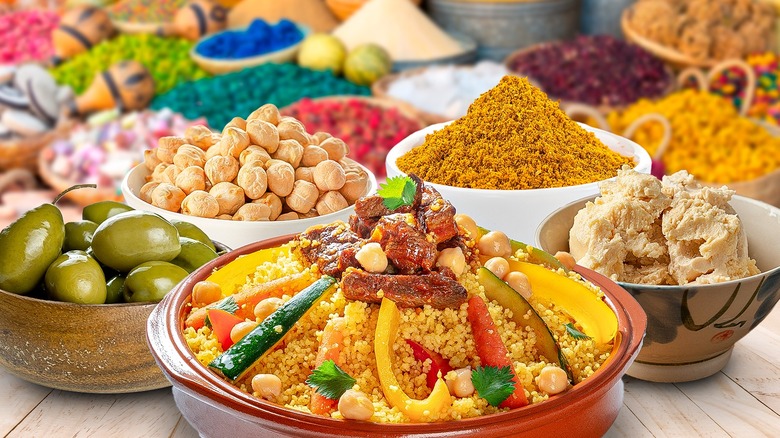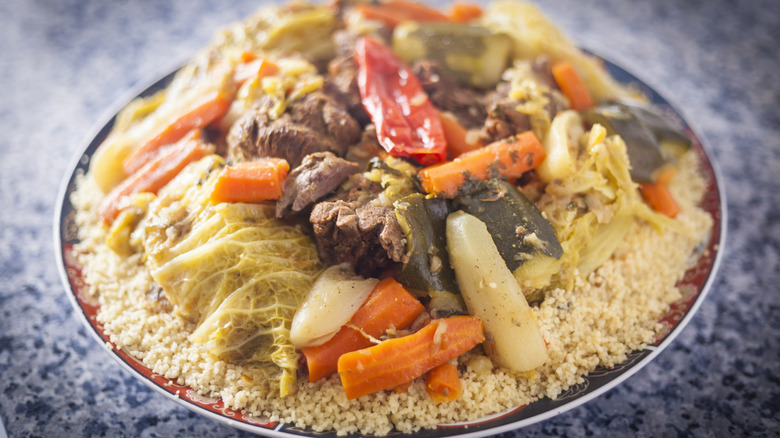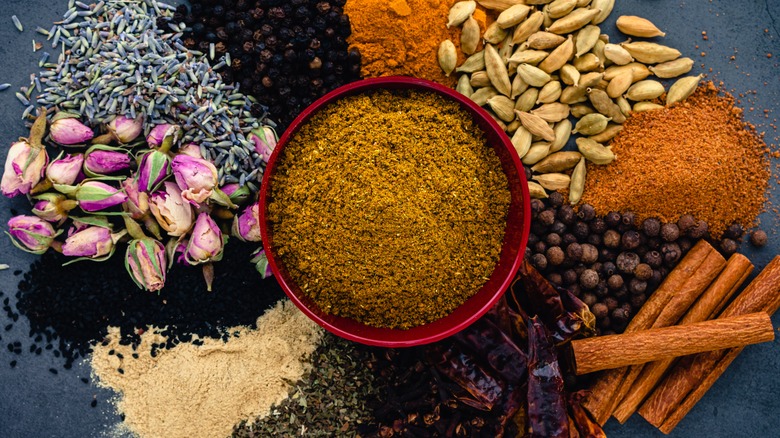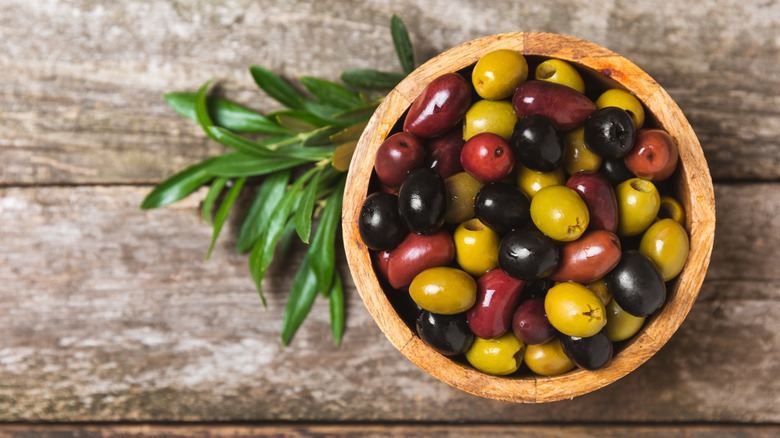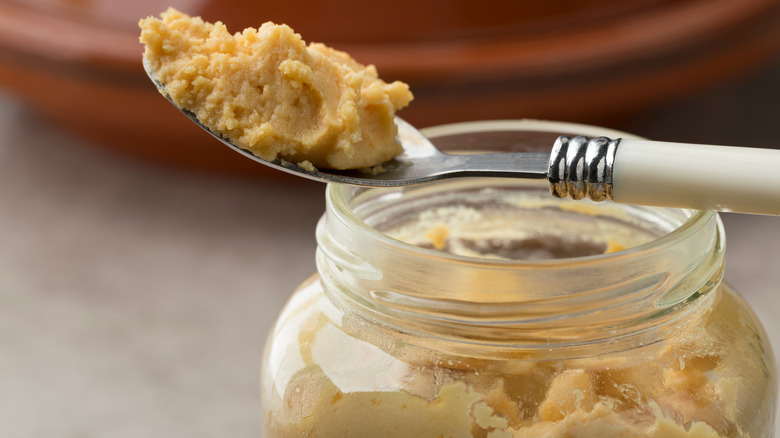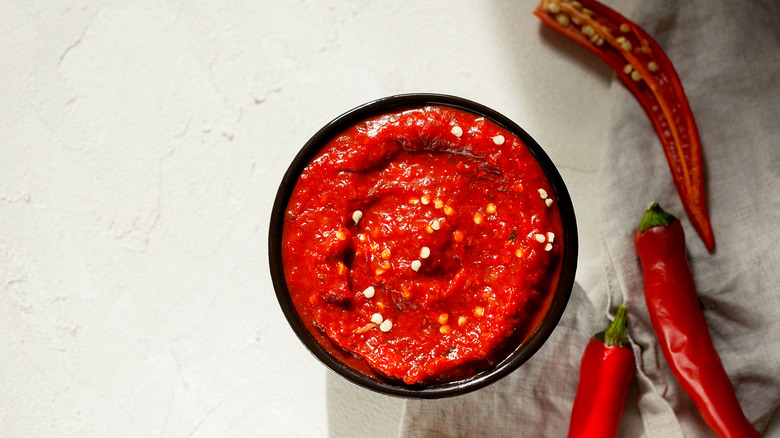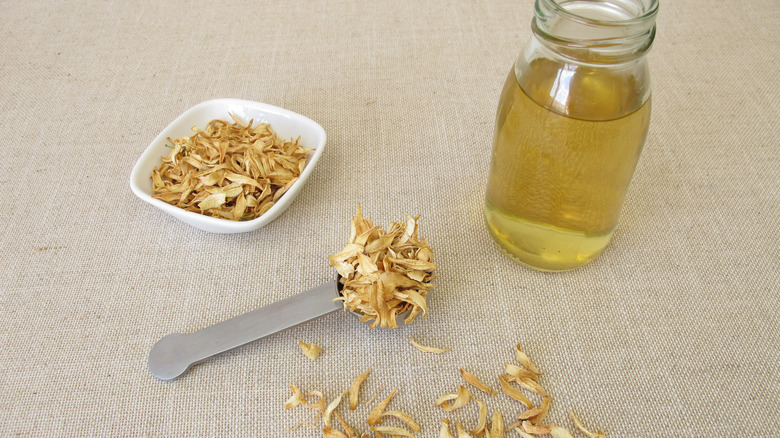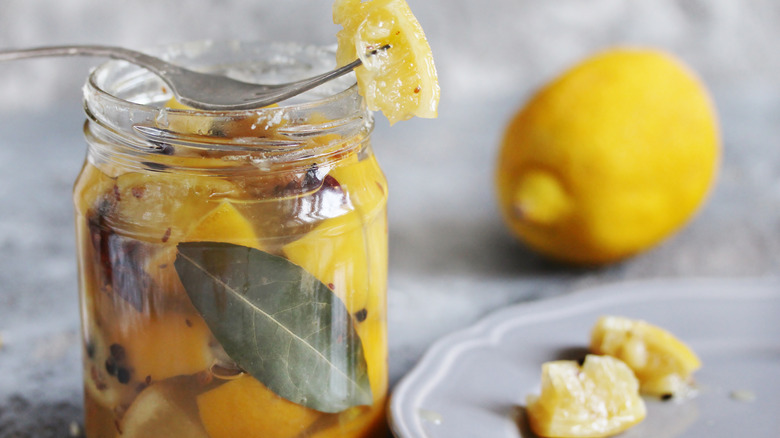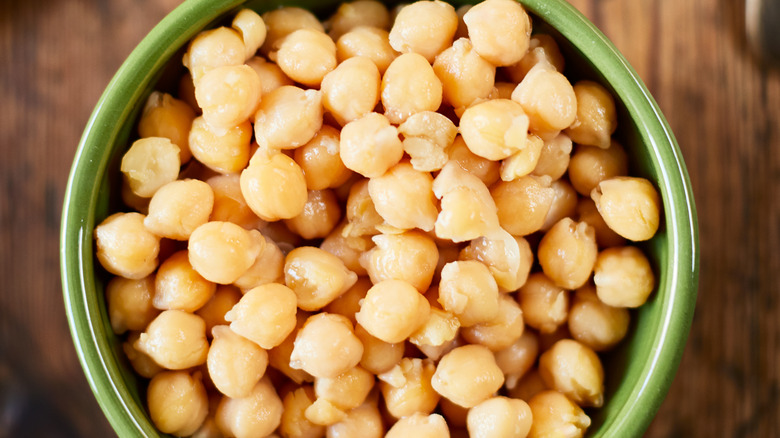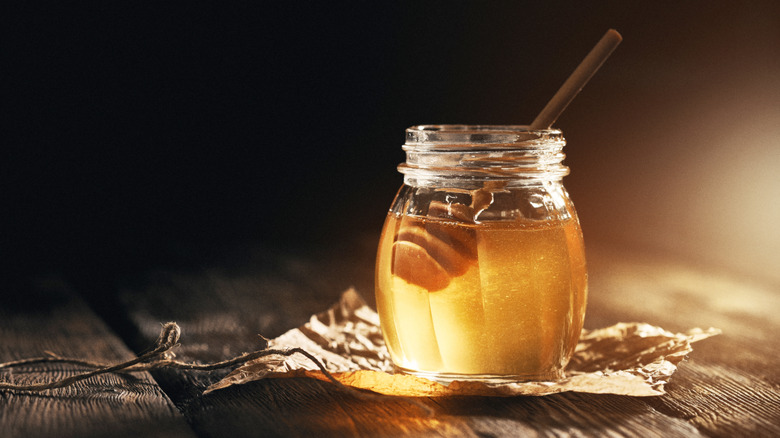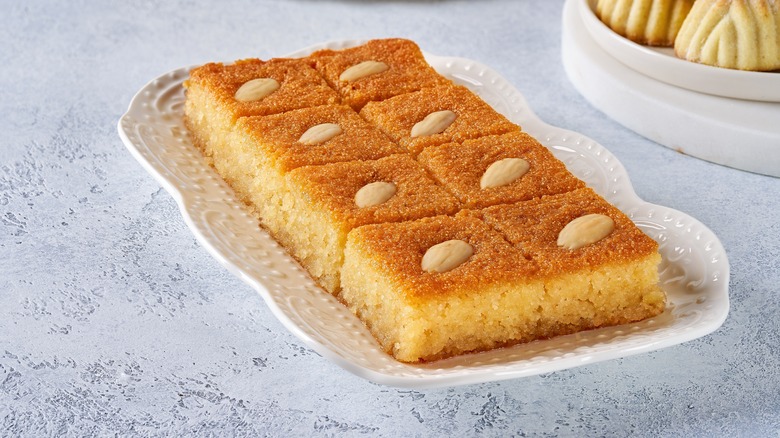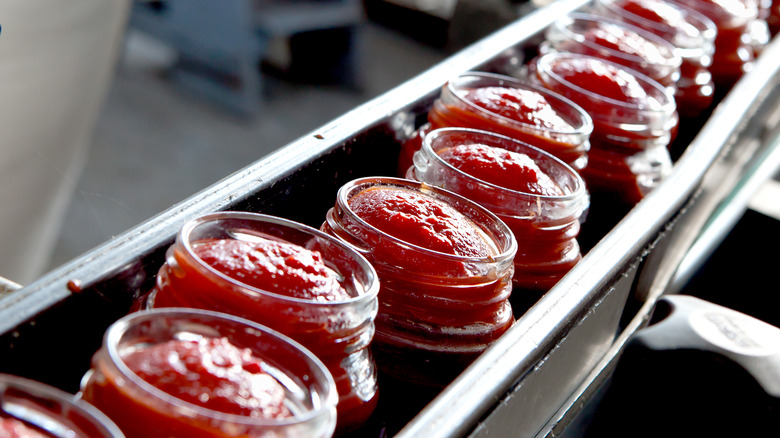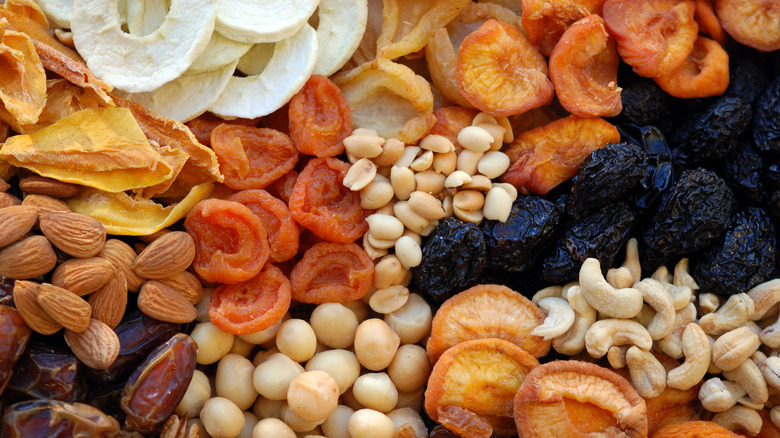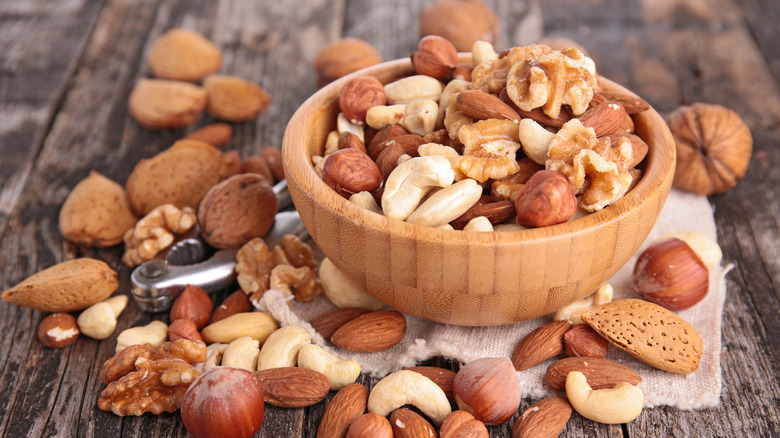13 Essential Ingredients For Moroccan Cooking
Moroccan cuisine is one of the most well-known North African cuisines and has been gaining popularity all over the world. The dishes are diverse and range from spicy chickpea soups to colorful seven-vegetable couscous towers to fall-off-the-bone chicken tagines. One thing they all have in common is bold flavors. The dishes were full of fresh produce, relying heavily on vegetables to add flavor to meat or fish dishes. Sometimes fruit was included too because Moroccan cuisine often utilizes both sweet and savory in the same dish, like in a lamb tagine that uses prunes or dried apricots.
As a fellow North African who spent some time living in Morocco, I fell in love with the spirit of hospitality and the philosophy of sharing food. Individual plates are very rare, and usually, you are served one big dish or dishes in the center of a table that everyone eats from. I spent time in the kitchen and dined with numerous home cooks who taught me the importance of fresh, seasonal ingredients and the right combination of spices to make succulent, tasty meals. While every household has its own techniques and "secret ingredients," these are some of the most common pantry items you need to have for cooking Moroccan cuisine.
Couscous
You can't talk about Moroccan cuisine without talking about couscous. This popular ingredient is the backbone of the national dish in Morocco, often served with seven vegetables and either lamb, beef, or chicken. While it's often mistaken for a grain, it's technically a pasta made from semolina wheat, rolled into little flakes that are then steamed until soft and fluffy.
Couscous is traditionally eaten every Friday in Morocco, but it is not limited to that. It can take hours to prepare the impressive seven-vegetable couscous, and it's always served on special occasions, in the middle of the table, and shared among guests. While fresh couscous has to be steamed, you can get instant couscous, which is steamed and dried and can be fluffed up with some boiling water and ready to eat within minutes. You can try this Moroccan couscous recipe, serve it plain as a base to stews and tagines, add it to salads, or with some spiced roasted vegetables. This versatile ingredient can be cooked in any way you prefer. It can also be served sweet with milk and sugar, which is usually a fan favorite among kids.
Ras el hanout
You can't talk about Moroccan cooking without talking about ras el hanout, the classic spice blend to boost rich meat dishes. Roughly translated from Arabic as "head of the shop" (meaning the best on offer or "top shelf"), ras el hanout is a blend of herbs and species that commonly include turmeric, ginger, cloves, cumin, cinnamon, pepper, fenugreek, and nutmeg. Sometimes, depending on the region or even city, other less common ingredients are added, like rosebuds, galangal, nigella seeds, or grains of paradise. This blend can include up to as many as 80 ingredients, which makes for a pretty interesting complexity in your food.
You can use ras el hanout in many different ways. It goes great with rich grilled meats like lamb or chicken, and it's also possible to add it to stews or soups. You can also mix it into yogurt to make a flavorful dip or add some melted butter to create a spiced butter marinade for fish. Some people use it unexpectedly, like making a spiced hot chocolate drink or even a sprinkle for popcorn.
Olives
Olives aren't always associated with Moroccan cuisine, but they are actually crucial to the Moroccan table, where you'll always at least find a jar or a couple of jars available. They are so ubiquitous in Morroco that you find stores that are entirely dedicated to different olive varieties. You can also find differently seasoned and spiced olives, which range from mild tasting to more acidic or bitter, with preserved lemons, pickled turnips, carrots, different herbaceous mixes, and chile-flavored olives.
When it comes to cooking, olives are an integral part of tagines, especially with chicken. You can always find chicken and olive tagines being served in most restaurants or homes as a weeknight dish. Often, just a few are enough to add the zingy sharpness needed for a chicken tagine to impart that subtle saltiness throughout the dish. Olives are also added to broth-based dishes or even served on their own as a cooked olive salad with tomato paste and spices.
Smen/fermented clarified butter
Clarified butter is one of the most common sources of fat used all over North Africa, but in Morocco, the version of this, called smen, is a salted fermented clarified butter with a pungent aroma. With a slight likeness to blue cheese, smen may take some getting used to if you're not familiar with it, but it provides a complex, rich flavor to many types of dishes, including couscous, tagines, k'dras (a type of stew) or simply on bread. Some even put a little in their coffee, which makes for a "bullet coffee" with more umami. Whatever you use it in, it's important to note that you only need to use a little bit to get a strong flavor.
Smen is made by heating up butter to remove the solids from the liquid; then, the solids are salted and placed in jars to age, usually underground. It came about as a way to preserve butter before the days of refrigeration, and therefore, it can last for a very long time. The folk tale told around the use of smen is that in old Berber traditions, a jar of smen would be buried in the ground on the day of the birth of a daughter, to be dug up on her wedding day to season the wedding food.
Harissa Paste
While harissa paste may have originated in Tunisia, it's become a staple in many North African countries, and Morocco is no different. It's one of the most versatile ingredients to add flavor to a recipe. While specific components in harissa paste may change between countries and even regions, it's most commonly made from dried chile peppers, olive oil, garlic, and various spices like cumin, coriander, and caraway. Some variations also include tomato paste, preserved lemons, or rose petals. It varies in the level of heat it has, from very mild to spicy, depending on the type of chile used, and is usually slightly sweet, smokey and tangy. While it's often available in jars in grocery stores, there's a benefit to making your own paste from scratch since you can adjust the heat level and emphasize the flavors you like best.
The best thing about harissa is that it's an ingredient you can cook with and a ready-to-eat condiment you can add to your plate after cooking. In Moroccan cuisine, it's mostly used to marinate grilled meat, fish, and chicken, added to couscous dishes, or as a hot sauce for eggs. However, it's not limited to these, and there are so many ways you can use it. Add it to yogurt to make a dip or sauce, deepen the flavor of your soups, dress up your roasted vegetables, or even spread it in a grilled cheese; the possibilities are endless.
Orange blossom water
Orange blossom water or orange flower water is one of the most common ingredients in Moroccan cuisine. Made from literal orange blossom flowers, this essence is in various desserts and baked goods, in tea, coffee, and even in water. It's also customarily used as a perfume and in soaps because of its fresh scent. Surprisingly, it's even used in savory dishes like soup, tomato jam, couscous, and chicken pastilla, a sweet and savory pastry. One of the most popular foods you'll find this ingredient in is a Moroccan brioche-style aniseed bun called krachel, which is topped with sesame seeds, and in mahalabia, a panna-cotta-like milk pudding. It's also sometimes drizzled onto orange slices with some cinnamon, in fruit salads, custard, and in a whole host of different cookies.
It's a truly ubiquitous ingredient in Moroccan cuisine, and you'll find this mild floral aroma in almost every home, alongside rose water. Although the flavor and scent differ, they are sometimes used interchangeably, especially in desserts and homemade lemonades. Both go well with creamy desserts or with citrus or vanilla flavors. You only need a little bit to flavor your dish, and always start with just a few drops because if you add too much, it can start to taste soapy.
Preserved lemons
Pickles and preserves are really important in Middle Eastern cuisine in general, and preserved lemons play a special role in various dishes across the region. In Morocco, they're included in many sauces and salsas and are crucial to certain chermoula mixes, harissa pastes, and tagines. Whole lemons are preserved in salt, and the result is quite different. The rinds become soft, and the sharp acidity is transformed into a complex flavor of salty, sour, and bitter. The experience of eating preserved lemons is completely different from fresh lemons, and if you've never tried them before, it's worth trying since there's nothing quite like it.
In Morocco, preserved lemons are made using a special variety of lemons that are slightly sweeter and have thinner skin, making them more suitable for being eaten whole in a preserve. They add a great depth of flavor to soups, salads, and tagines and go especially well with chicken and fatty meats, where they cut through the richness.
Chickpeas
You might know chickpeas as the star behind hummus, but they have plenty of other uses, especially in Moroccan cuisine, where they're featured in plenty of recipes like couscous, tagines, and the most popular Moroccan soup, called harira. This spicy tomato-based soup is often served as a starter, especially during Ramadan, when it's the dish that people eat to break their fast. Often served with vermicelli, spices, chickpeas, and lentils, harira can be made vegan or cooked with meats like lamb.
Chickpeas, like other legumes, are often underutilized in Western kitchens but are a great way to eat plant-based protein. This creamy, nutty-tasting legume absorbs flavor really well and adds body and richness to dishes. They can even be turned into a crunchy savory snack, and in North Africa, even a sweet one that resembles peanut brittle. They can be bought dry and then soaked overnight in water before you cook them or buy them preserved in cans or jars for a quick way to add some more protein to a vegetarian soup, curry, or stew. Warm up with this Morrocan chickpea stew recipe for a flavor-packed, hearty meal on a cold winter's night.
Honey
Honey is so important to Moroccan cooking, as it's used not just as a sweetener but also for its flavor in baked goods like cakes and doughnuts. It's also always served with baghrir, a popular type of spongey pancake that's served for breakfast with some butter and honey. You'll likely never find simple syrup or maple syrup on these pancakes, but honey will always be on the table. It's also used to sweeten tea and coffee and is often used for medicinal purposes due to its anti-bacterial qualities.
It's also a key ingredient in the famous Moroccan pastry called chebakia, which is customarily eaten during Ramadan. The rose-shaped dough is deep fried and then drenched in a syrup made of honey and orange blossom water, then sprinkled with sesame seeds. You can find numerous types of honey, from eucalyptus flower honey to chamomile honey, orange blossom honey, creamed honey, brown honey, and darker honey hues that resemble blackstrap molasses.
Semolina
You might know semolina flour as the base of couscous, but this ingredient is central to all kinds of other dishes in Moroccan cuisine. In fact, it's likely to be the most popular type of flour in Morocco, used in making breads, pastries, cakes, pancakes, and even porridge. It's the main ingredient in msemen, the Moroccan-style crepe your morning needs. The flaky, buttery pastry meets flatbread is made with semolina flour and butter and is eaten for breakfast with some cheese or honey and tea. Another popular bread called khobz dar, or, as it's translated from Arabic, "house bread," is also made with semolina and olive oil and is known as the entry-level bread recipe that everyone needs to learn.
Semolina is also wildly popular in Moroccan cakes and desserts, like basbousa, a semolina cake drenched in syrup and popular all over North Africa and the Middle East. You can find both coarse and fine semolina, each with a different role to play, depending on the desired texture.
Tomato paste
Tomato paste or concentrated tomatoes are a crucial ingredient for many Mediterranean cuisines, and it's the base of plenty of Moroccan recipes like harira soup and spiced kofta (meatballs) in tomato sauce. It's a long-lasting ingredient that you can stock up on and use in many ways. Add it to stews or anything brothy and saucy, or saute it with some onions and garlic as the base for a pasta sauce. As one of the easiest and most affordable ways to add both umami and acid to a dish, tomato paste is a key ingredient to include in your pantry for many types of cuisine. To use it in Morrocan dishes, you can cook it with spices like cumin, cinnamon, and coriander or spice mixes like ras el hanout. You can also add it to your homemade harissa paste, along with dried chiles to make a sweeter and thicker paste.
Dried fruits
Certain dried fruits like raisins, prunes, and apricots are really popular in Moroccan food, and the cuisine is known for mixing sweet and savory in the same dish. You can find lamb and dried prune tagine, dried apricots with chicken and beef, or even raisins in various tagines, rice, and couscous dishes, and they add not only sweetness but sometimes a slightly sour taste, too. It's also common to rehydrate dried fruits with hot water and then cool them to make a quick compote, eaten as a dessert during summer.
Dried fruits are also used in other ways, like a sweet beverage that's made from apricot paste. Another popular dried fruit is dates, which are very important for breaking fast during Ramadan. Dates are used in various desserts and cookies, and stuffed dates are a popular sweet snack, usually with a nut-paste filling of walnuts or almonds. They're also turned into date paste and date syrup (or date molasses), used in baking, as a sweetener, and even in some savory dishes. Dates are also sometimes sauteed with butter and turned into a sweet spread for bread.
Nuts
Nuts are one of the cornerstones of Moroccan cooking, as there are a wide variety of nuts that are part of some of the most popular dishes. Almonds, in particular, play a big role in sweet treats and are often used as the filling for cookies like ghriba, an almond and semolina crumbly biscuit, and cornes de gazelle, a shortbread with an almond filling that's shaped like a crescent or a horn of a gazelle, as the name suggests. Almonds are also added to plenty of savory dishes like couscous and tagine, often in the same dishes you'd add dried fruit to, to add more bite and texture to food that's been slow-cooked until completely soft and tender. Another popular nut is walnuts, which are usually stuffed into dates or in a walnut version of ghriba cookies. Pistachios are another popular nut, often in between flaky baklava layers or as the filling in briouats, a Moroccan sweet samosa.
Of course, nuts are also often roasted, salted, and eaten as a snack in their own right and are sometimes spiced and sold in bags by street food vendors on sidewalks all over the big cities. Nuts are often also dipped in honey and rolled in sesame seeds in praline-like sweets. They're also served as is, along with dates and dried fruits for desserts or breaking fast during Ramadan and large feasts. Finally, they're added to dried fruit compotes for a little bit of a crunch in the cold summer dessert.
